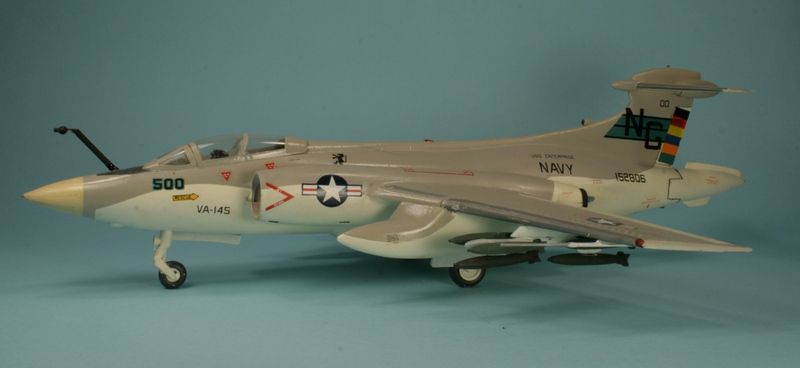Have read that some MDAP money went into the program and that the USN had expressed "a mild interest" in the type. So lets just amp that up to buying it. This will probably kill the A-6 program, though it may have been far enough long that some prototypes may have been built.. not sure about the timelines of both aircraft off the top of my head at the moment.
It would be a decent way of enhancing the alliance, propping up the British economy a wee bit and it might even spur some innovation domestically by mixing things up a little.
So what is this bird going to look like? How do we think it will fair in Vietnam?
Okay, so the timeline between the two goes like this:
June 1952: RN issues NA.39 with the following requirements:
The requirement was formalized as "Naval Staff Requirement Number 39 (NA.39)" in June 1952, which called for a two-seat carrier-based aircraft that could carry a nuclear weapon internally, fly at a speed of Mach 0.85 at an altitude of 60 meters (200 feet), and operate over a combat radius of at least 740 kilometers (460 miles). It was to have an offensive radar system and a radar altimeter. Total weapons load was to be 1.8 tonnes (4,000 pounds); the length could be no more than 15.5 meters (51 feet) in stowed configuration to allow accommodation on existing carrier-deck elevators; and the maximum weight was to be no more than 20.4 tonnes (45,000 pounds). The aircraft was also to be able to act as a tanker.
Summer 1954: NA.39 design competition is frozen.
July 1955: Blackburn B.103 is chosen for production.
1956: USN RFP issued for twin-seat all-weather strike aircraft.
January 1958: Grumman wins competition, plane designated A2F.
April 1958: Buccaneer S.1 prototype flies.
1959: Contract placed for eight developmental A2F prototypes.
Early 1960: S.1 carrier trials begin
July 1960: A2F prototype flies.
August 1960: Buccaneer name assigned.
August 1961: First S.1s delivered
January 1962: Buccaneer S.2 ordered
July 1962: Number 801 squadron operational.
1963: EA-6A flies; A-6A enters service.
May 1963: Buccaneer S.2 flies.
October 1965: Buccaneer S.2 enters operational service.
So I'd say the timing works: the B.103 design was ready by the time the US Navy issued the RFP for what became the Intruder, and the S.1 prototype was flying a bare few months after Grumman won the original competition. The issue, of course, being the engine problem and the fact that the S.2 took so long to develop, but it might be possible to get the S.2 early if the US Navy buys in; the S.1, due to its low-thrust Gyron Junior engines, had a much lower bombload than the Intruder, and regardless of the takeoff problem more thrust means more weapons and that would interest the US Navy.
The problem with
that is which engine to use. The Spey only ran in 1964 and the earliest it was placed on an aircraft design was in 1959 for the Hawker Siddeley Trident in mid-1959. This is, I believe, rather tight timing for a development program started in 1956 and intending to send out development contracts in 1959. Unfortunately, the TF30 runs into a similar problem. The J52 is readily available but only a modest power increase over the Gyron Junior.
I guess it would automatically become the basis for a collaborative project with one of the US Navy aeroplane suppliers but not Grumman as they already had the A6. So that’s either LTV or MacDonald Douglas;- either way one of there stealing the A6 contract from Grumman make interesting what ifs? The Buccaneer would now access some serious development potential with US engines and avionics maybe even leading to a USAF purchase……
I remember reading an account of a senior US Navy officer going back home after an exchange tour on the Buccaneer making a serious resolution to press a case for Buccaneer acquisition within the Pentagon. I think I remember a mention of some informal talks between HSA and LTV….. obviously didn’t lead to anything.
Probably LTV, then; the Navy had just canned Douglas' Skylancer, for reasons suspected to include reducing Douglas' large share of the Navy's tactical aircraft inventory.
I should note that, if bobtdwarf's speculation over on the "What if Germany did not go for the F-104" is correct, this whole scenario stands a good chance of giving the Super Tiger a leg up for foreign sales.


